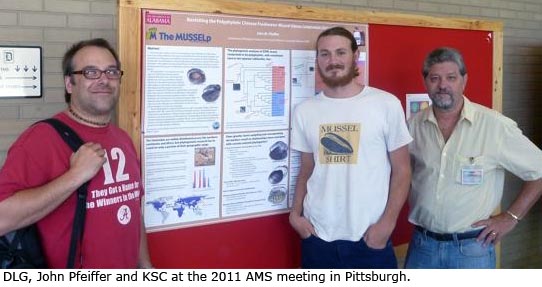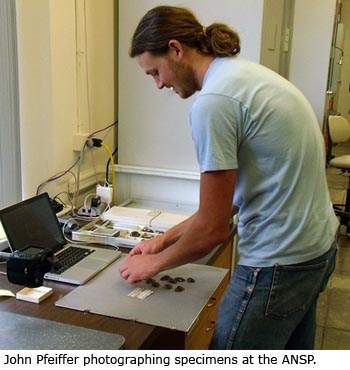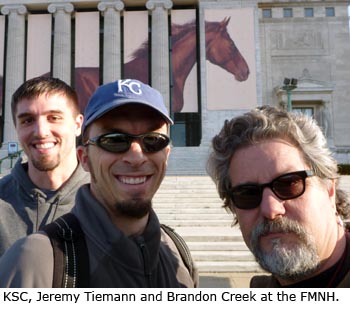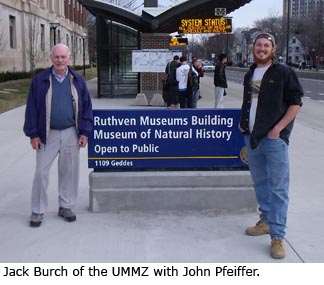| Page last updated
15 December 2011 |
What's New with the MUSSELp?
The highlights of 2011.
13 June-27 July 2011 -- A Busy Summer for the MUSSELp. Our frenetic summer recently culminated at the annual meeting of the American Malacological Society. KSC, DLG, INHS collaborator Jeremy Tiemann, and Bama graduate student John Pfeiffer converged on Duquesne University to mingle with our fellow malacologists and provide a little freshwater bivalve perspective to a gathering dominated by marine folks.

DLG covered the freshwater bivalves for the opening symposium on The Great Unanswered Questions in malacology. The scope of his lecture, “The Global Diversity of Freshwater Bivalves,” was not limited to the Unionoida but also reviewed the extent of our knowledge on the phylogeny of sphaeriids, cyrenids and other freshwater bivalves as well. KSC and Jeremy participated in a symposium on the history of malacology with their talk, “The Illinois Natural History Survey / University of Illinois Museum of Natural History Mollusk Collection.” As the big finale to the conference, John Pfeiffer won the award for best student poster for his contribution, “Polyphyly of the freshwater mussel genus Lamprotula (Mollusca: Bivalvia: Unionidae).” These presentations were all well received, and it was great to meet the newer members of the AMS and see so many old friends. |
 Earlier in the summer, John Pfeiffer traveled to Philadelphia to study Asian freshwater mussels at the Academy of Natural Sciences. John’s research was funded by a generous Jessup Fellowship from the ANSP, and over the course of two weeks, John capture lots of specimen and literature data for the MUSSEL Project. Click here to read John’s report on his adventure in the City of Brotherly Love. Earlier in the summer, John Pfeiffer traveled to Philadelphia to study Asian freshwater mussels at the Academy of Natural Sciences. John’s research was funded by a generous Jessup Fellowship from the ANSP, and over the course of two weeks, John capture lots of specimen and literature data for the MUSSEL Project. Click here to read John’s report on his adventure in the City of Brotherly Love.
|
While John was doing that, KSC, Jeremy Tiemann, Brandon Creek and Josh Sherwood collected Lampsilis Cardium for the BivAToL project.

Prime mussel spot in the Great Corn Desert.
|
 2-3 May 2011 -- Gathering Specimen Data from the FMNH. KSC, Jeremy Tiemann and Brandon Creek photographed southeast Asian unionids for the MUSSELp at the Field Museum in Chicago. In all, 234 freshwater mussel were digitally photographed and added to the MUSSELpdb. In addition, KSC et al. collected data on freshwater gastropods -- specifically lymnaeids, viviparids and pleurocerids. 2-3 May 2011 -- Gathering Specimen Data from the FMNH. KSC, Jeremy Tiemann and Brandon Creek photographed southeast Asian unionids for the MUSSELp at the Field Museum in Chicago. In all, 234 freshwater mussel were digitally photographed and added to the MUSSELpdb. In addition, KSC et al. collected data on freshwater gastropods -- specifically lymnaeids, viviparids and pleurocerids.
|
 22 March 2011 -- Spring Term 2011: Expanding the Bama Lab and the MUSSELpdb. Spring term has been busy for the MUSSELp so far. John Pfeiffer joined the Graf Lab at the University of Alabama to work on mussel systematics, Sarah Wofford continued working in the lab in several important capacities, and the project expanded further into SE Asian mussels. 22 March 2011 -- Spring Term 2011: Expanding the Bama Lab and the MUSSELpdb. Spring term has been busy for the MUSSELp so far. John Pfeiffer joined the Graf Lab at the University of Alabama to work on mussel systematics, Sarah Wofford continued working in the lab in several important capacities, and the project expanded further into SE Asian mussels.
Graduate student John Pfeiffer finished his undergraduate studies at Northern Michigan University last spring, and now he is doing research the family-level relationships of freshwater mussels for the Bivalve Assembling the Tree of Life Project. So far, John has been getting up to speed on lab protocols, and he has started generating DNA sequences and studying mussel morphology. Watch this space for interesting results from John's work.
Undergraduate Sarah Wofford has been working in a curatorial capacity this term, moving dry mussel bodies in the ultracold freezer to ethanol-filled cryotubes. It is a dirty job, but someone has to do it. This will better protect the mussel tissues inherited by DLG and open up A LOT of space for future specimen storage. Sarah also worked up the specimen images that DLG captured in Paris last fall.
For Spring Break, there was no break. John and DLG made a whirlwind trip to the University of Michigan Museum of Zoology in Ann Arbor to capture specimen data in that collection for tropical SE Asian freshwater mussels. Two days of driving, two days of back-aching collections work, and almost 950 photographs! Thanks to our friends in the Mollusk Division at the UMMZ for being so accommodating. |
|